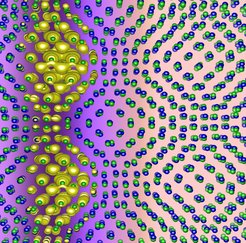Twisted 2D material gives new insights into strongly correlated 1D physics

The four scientists examined germanium selenide (GeSe), a material with a rectangular unit cell, rather than focusing on lattices with three- or six-fold symmetries like graphene or WSe2. By combining large scale ab-initio and density matrix renormalization group calculations, the researchers showed that the Moiré interference pattern will create parallel wires of correlated one-dimensional systems. Their work has now been published in Nature Communications.
This considerably broadens the scope for realizable structures using Moiré twisting physics and provides an inroad into the challenging question of how a correlated system crosses over from two dimensions to one. Because the particles cannot pass each other as they would in a multi-dimensional context, one-dimensional systems are intriguing, as correlations necessarily lead to collective excitations.
Dante Kennes says the combined analysis of the two numerical methods yielded great results: “We were able to classify the phase diagram of two sheets of twisted GeSe and found a plethora of realizable phases of matter, including correlated Mott insulators and the so-called Luttinger Liquid phase, which reveals physics defying our independent particle picture in fundamental ways.” Lede Xian adds: “We established twisted GeSe as an exciting platform to understand strongly correlated 1D physics and the crossover from one to two dimensions in a highly tunable and experimentally accessible manner.”
This research opens up many future directions. One particularly intriguing approach is to substitute elements in GeSe to achieve higher spin-orbit coupling. Martin Claassen from the Center for Computational Quantum Physics at the Flatiron Institute points out: “Coupling such a system to a superconducting substrate would result in topologically protected Majorana edge modes under the right conditions.” Those states are particularly important as they could be used as so-called qubits; the quantum equivalent of a classical bit, which is the fundamental computational building block.
Therefore, the ability to create many parallel Moiré wires with Majoranas attached at their ends reveals an intriguing future inroad for unlocking topological quantum computing in a naturally scalable way. Ángel Rubio, the director of the MPSD’s Theory department, concludes: “The present work provides valuable insights into how twisting 2D materials can be used to create properties on demand in quantum materials.”












